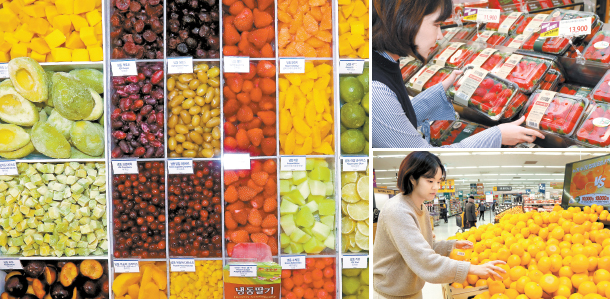Local fruit growers corner the high-end market

Left: Frozen imported fruits are displayed during the Seoul Food exhibition hosted by the Korea Trade-Investment Promotion Agency in May 2019. Top right: An Emart customer picks up local strawberries. Above right: A customer chooses between cross-bred tangor fruit and cheonhyehyang oranges at a store in Seoul. [KIM KYOUNG-ROK, EMART]
Korea’s fruit imports have climbed steadily in recent years but dropped 8.6 percent last year, from 955,404 tons to 873,137 tons, according to data from the Korea Customs Service. The decrease in imports amounted to 221.9 billion won ($185.1 million).
Korea’s expansion of free trade has led to an increase in fruit imports every year. Starting with an agreement between Korea and Chile that went into effect in 2004, and continuing to the Korea-Central America free trade agreement in 2018, Korea has signed 16 deals with 57 countries, according to the Korea Rural Economic Institute. As the imported goods diversified, fruit imports made steady gains in the domestic market, jumping from 349,949 tons in 2000 to 504,059 tons in 2004. By 2018, Korean imports had grown to 955,404 tons.
After signing a free trade agreement with the United States, imports of U.S. oranges increased, until last year’s torrential rains in California damaged the 2019 crop and delayed harvest by preventing farmers from using heavy equipment in the sodden groves.
Foul weather also impacted U.S. cherry exports. The crop’s value has plummeted due to low sugar levels resulting from insufficient sunlight during the growing period. Small yields led to the increase in price, but the sale of low-quality cherries at high prices made Korean consumers turn their backs on cherries from the states. U.S. grapes, which account for 67 percent of Korea’s grape imports, similarly suffered from poor weather.
Other countries suffered from weak fruit harvests last year. A delay in the Israeli grapefruit harvest caused imports of the citrus to fall 21 percent on year last year. Pineapple imports dropped by 13 percent on year, following weak crop yields in the Philippines.
Bananas, which take up the largest volume of fruit imports, are facing a drop in domestic consumption. From the existing importing country the Philippines, the expansion of the free trade agreement increased banana importers to Central and South America, including Ecuador and Guatemala, but the imports decreased due to a decrease in domestic demand.
A person who imports bananas said bananas tend to be more associated with desserts in Korea, rather than as a stand-alone meal.
“Despite its drop in price, banana consumption decreased due to the diversification of domestic fruits,” the person said.
But after struggling alongside growing imports, the domestic fruit industry has begun focusing on high-end products. Domestic fruit sales increased 8 percent last year compared with 2018, according to statistics released by Emart. The growth rate for domestic grapes was 81.7 percent, followed by cheonhyehyang oranges at 58.7 percent, melons at 21.9 percent and strawberries at 11.7 percent.
“Despite the economic recession, premium Korean fruits are growing rapidly, leading to a rise in sales,” said Choi Ji-yoon, a member of Emart’s fruit team. “We will continue to discover various pure domestic varieties of agricultural products.”
Office worker Kim Ji-hoon said he’s looking for a fruit to replace his preferred cherries.
“I regularly bought cherries, but the price went up while the sweetness went down,” Kim said. “I tend to eat grapes or tangor [a portmanteau of “tangerine” and “orange”] products these days.”
Last year, the domestic shine muscat, a variety of green grapes, emerged as a rival to challenge imported grapes. The grape variety is comparatively expensive, costing at least 10,000 won per bunch. Despite the higher price, the “repurchase rate,” or the rate of returning customers, was also high.
The repurchasing rate of shine muscat grapes jumped to 61.6 percent last year from 28.1 percent in 2017, according to a consumer survey conducted by the Korea Rural Economic Institute’s department of agricultural outlook. Farms cultivating the grapes nearly quadrupled between 2017 and 2019, from 472 hectares (1166.34 acres) to 1,867 hectares.
High-quality cross-bred tangor fruits, including hallabong, cheonhyehyang and hwanggeumhyang, are replacing imported oranges. The domestically produced fruits have gained popularity since the mid-2010s for their juiciness and unique scent. Sales of tangor fruits rose 35 percent from 2018 to 2019.
“The demand for oranges has decreased due to the replacement of imported oranges by fruits including hwanggeumhyang and cheonhyehyang,” a Garak Market official said. “As more farms are cultivating tangor fruits, the prices will drop, and the demand will surge.”
Korean strawberries have also settled into the market as premium products through “smart farm” techniques that control temperature, humidity and carbon dioxide levels.
The distribution industry is also helping to grow the reach of domestic fruits. Emart said its “Power of Local Foods” initiative has been promoting local products from farmers and fishermen since 2015, by entirely supporting the distribution process, including quality control, market channel expansion and the marketing process.
The company raised 25.6 billion won in revenue from 42 local products in 2015. Revenue more than doubled by 2019 to 54 billion won from 125 local products. In particular, premium domestic strawberry products, including janghee, damyang and “smart farm” strawberries brought in 6.5 billion won last year.
“When I went shopping to buy seasonal fruit, I was surprised how there were so many different strawberry products to choose from. Products have high sugar levels, so my family is very satisfied,” Kang Min-young, a 38-year-old homemaker, said. “I’ve been repurchasing strawberries, as the flavor and scent are so good.”
BY KWAK JAE-MIN [kim.yeonah@joongang.co.kr]










with the Korea JoongAng Daily
To write comments, please log in to one of the accounts.
Standards Board Policy (0/250자)